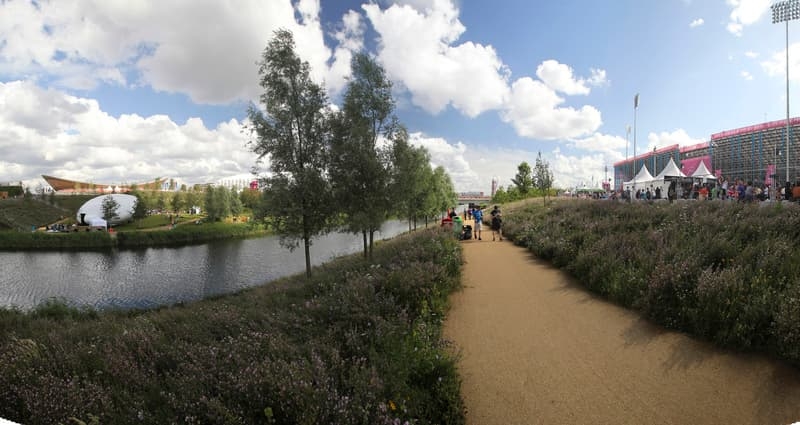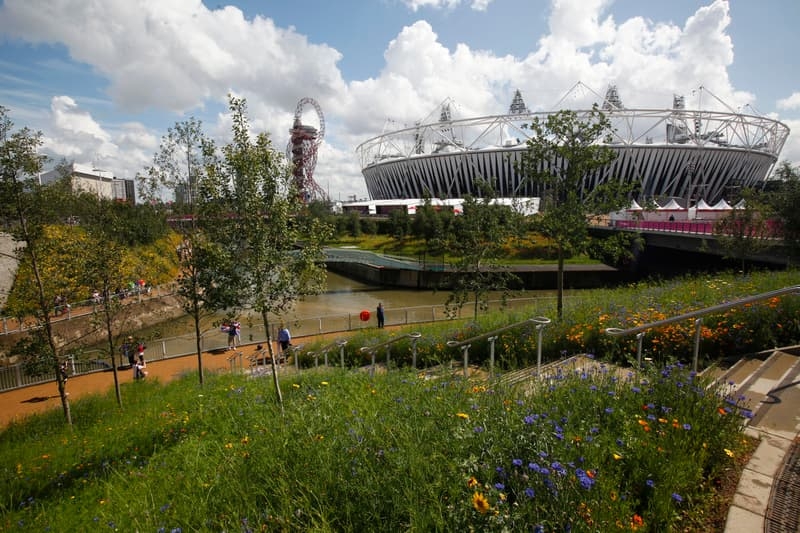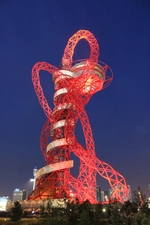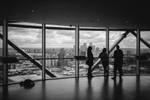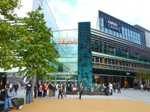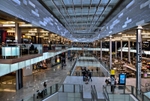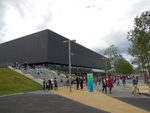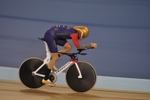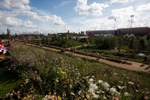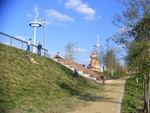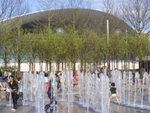1. The London Stadium
The London Stadium, surrounded on three sides by waterways, is at the heart of the Queen Elizabeth Olympic Park.
It hosted the 2012 Olympic and Paralympic Games, and is now used to host premiership football and other world-class sporting events.
The Olympic Games
The 80,000 capacity stadium has a distinctive white tubular steel exterior and is topped by triangular lighting rigs. LED paddles are found behind every seat, allowing animated content to be shown on the stands during the acclaimed Olympic opening ceremony.
That ceremony was peculiarly British, featuring scenes from British history (such as the industrial revolution), a tribute to the National Health Service, Sir Tim Berners-Lee (the British inventor of the internet), and—most remarkably—the Queen meeting James Bond and then jumping out of a helicopter and parachuting into the Olympic Stadium.
The Olympic Stadium was home to some remarkable sporting feats, such as Mo Fareh winning gold medals in both the 5000 and 10000 metres (a feat not achieved since 1984), David Rudisha smashing the 800 metre world record, and Usain Bolt winning the 100 and 200 metre events (setting an Olympic record of 9.63 seconds in the 100 metres). Another key moment, which left few in the Olympic Stadium with dry eyes, was 34 year old Felix Sanchez breaking down in tears when receiving his 400 metre hurdles gold medal.
Premiership Football
West Ham's successful bid to lease the stadium means that premiership football now graces the stadium every two weeks or so during the football season. Finding a long-term tenant for the Olympic Stadium secures a key part of the Queen Elizabeth Olympic Park regeneration plan.
But West Ham's move to what has been renamed the London Stadium has not been a resounding success. First, there is the fact that the stadium retains a running track: this means that fans feel a long way away from the action (a problem exacerbated by the stadium's gently sloping stands). Secondly, there have been crowd control issues, with violence breaking out at a number of matches at the end of 2016. Thirdly, the team hasn't performed very well: it ended the 2016/17 season in 11th position in the league, hardly what its owners will have been hoping for after such a high-profile move.
The London Marathon Community Track
Behind the stadium is found the London Marathon Community Track, used by the Newham and Essex Beagles running club and by local schools and community groups. Funded by a £3.45 million grant from the London Marathon Charitable Trust, the track is intended to inspire people of all ages and abilities to take up an active lifestyle.
2. London Aquatics Centre
The Zaha Hadid designed London Aquatics Centre, with its wave-like roof, is an architectural gem.
Measuring 160 by 80 metres, the complex houses 50-metre competition and warm up pools and a 25 metre diving pool. It is found to the east of the Queen Elizabeth Olympic Park, close to Westfield Stratford City.
During the Olympics the Aquatics Centre saw Michael Phelps win a further six gold medals, taking his lifetime haul to 22 (18 golds, 2 silver and 2 bronze) and making him the most decorated Olympian of all time. The Chinese also had a great Olympic games, with 16 year-old Ye Shiwen wowing the Aquatics Centre spectators with golds in the 200 and 400 metres individual medleys.
The Aquatics Centre had a temporary capacity of 17,500 during the Olympics, which has now been reduced to 2,500. The venue opened to the public in 2014, with a swim costing £4.50!
But the Aquatics Centre still finds time to host international events. The LEN European Aquatics Championships were also held here during May 2016, featuring 900 of the best swimmers and divers in Europe (who will be looking to hone their skills in advance of the Rio Olympic Games).
Opening hours: 6am to 10.30pm
Prices: £4.50 peak times; £3.50 off-peak
3. ArcelorMittal Orbit
The ArcelorMittal Orbit is an observation platform in East London’s Queen Elizabeth Olympic Park.
Completed in time for the 2012 Summer Olympic Games, the Orbit is 114.5 metres tall and offers visitors great views over the Park, the nearby Canary Wharf and for up to 20 miles over London.
History
In 2008, the Mayor of London Boris Johnson and the Olympics minister Tessa Jowell decided that the Olympic Park needed ‘something extra’. They therefore announced a competition to design an Olympic Tower that was at least 100 metres in height.
The Orbit is designed by Sir Anish Kapoor, a former winner of the Turner prize, and Cecil Balmond. It was selected in March 2010 as the best of 50 entries submitted to an independent nine-person advisory panel. Construction started in November 2010, with the structure reaching its full height a year later.
The Orbit is now Britain’s largest work of public art and tallest sculpture. It was unveiled in May 2012, to mixed reviews. The Independent newspaper described it as containing ‘eight strands winding into each other and combined by rings like a jagged knot.’ Other commentators described the Orbit as a monument to the ego of the London Mayor, as at ‘Eyeful Tower’, and as a series of ‘horrific squiggles’.
During the Olympics, the Orbit was visited by 130,000 people. It was closed shortly thereafter, so that the Stratford site could undergo redevelopment. The Orbit re-opened on 5 April 2014, together with the rest of the south side of the Queen Elizabeth Olympic Park (which includes the London Aquatics Centre and a variety of stunning gardens surrounding the Olympic Stadium).
Construction
The Orbit is 114.5 metres (376 feet) tall, has observation decks at 76 metres and 80 metres and weighs 2,000 tonnes (the same weight as 1,136 London black cabs). It is constructed of steel with a recycled content of 60% that was produced in ArcellorMittal Limited’s plants around the world, held together by 35,000 bolts and protected by 19,000 litres of paint. The colour red was chosen because it symbolises luck in some Eastern cultures.
The Orbit cost £27 million to build, most of which was donated by Britain’s richest man Lakshmi Mittal, Chairman of the ArcelotMittal steel company. Structurally, the orbit contains two parts: the red tube lattice of red steel, surrounding a vertical tower or trunk which houses the elevators and supports the observation deck. At the bottom of the structure is found a huge 84-tonne conical canopy made of steel. The Orbit is unique for being the first structure of its kind to be constructed without the use of scaffolding.
The 600 pieces of steel making up the trunk was pre-fabricated by a team of 100 staff in Bolton, Lancashire.
Visiting the ArcelorMittal Orbit
Visitors take the express lift up to the Orbit’s top viewing platform, at a height of 80 metres. The ride takes 34 seconds and the views from the top are great.
Immediately below the Orbit is found the Olympic Stadium, currently being converted into West Ham United’s new football stadium, and the London Aquatics Centre.
A little further afield, you can see Stratford City, the Copper Box stadium (where handball was played during the Olympic games) and the velodrome (now converted into a large cycling centre, complete with mountain bike trails and BMX track).
To the South is the O2 Arena, Emirates Air Line and burgeoning Canary Wharf complex. Other buildings of note include the Shard, the City of London’s most famous new skyscrapers (such as the Heron Tower and Gherkin) and St Paul’s Cathedral.
The upper viewing platform has two mirror sculptures by Anish Kapoor, an outdoor balcony, and a ramp to the lower observation deck (at a height of 76 metres). You then have a choice: you can either get the lift back to the ground, or take 455 steps back down. If you choose to walk, which takes about 10 minutes, you follow the spiral walkway that snakes around the Orbit.
The Orbit has seen four marriage proposals: three during the Olympic Games and one since. It is now licenced to host weddings.
The Orbit hosts a number of events throughout the year. There are arts and crafts events for children, Christmas events (complete with Santa and Reindeer), and a bar on Friday evenings in December. 2015 sees the Orbit launch its abseiling experience days (costing £85 per person).
Tickets for the ArcelorMittal Orbit
Opening hours: 10am to 6pm (Apr-Sept); 10am to 4pm (Oct to Mar)
Price: £10 (adults); £7(concessions); £5 (children) (if booked in advance). A £5 supplement applies for The Slide at the Orbit.
4. Westfield Stratford City
Adjacent to the Queen Elizabeth Olympic Park is Westfield Stratford City, with almost 2 million square feet of retail space making it the largest shopping centre in Europe.
Westfield is arranged over five levels, with the anchor tenants—Waitrose, John Lewis and Marks and Spencers—occupying 36,000 square metres of floor space. Outside is found The Street, with more shops and a host of trendy restaurants and bars.
The facilities include a 17-screen Vue cinema, the 24-hour Aspers Casino, two hotels, 400 shops and 70 restaurants.
Westfield's shops include Apple, Armani, Boss, Calvin Klein, Guess, GANT, Lacoste, Reiss, Superdry, Hilfiger and Zara.
All types of food are catered for, with restaurants including Harry Ramsden's (English fish and chips), Strada (Italian), The Real Greek, Wagamama (Japanese) and Wahaca (Mexican).
5. Copper Box
The Copper Box, named after its distinctive external cladding, hosted fencing, handball, modern pentathlon and goalball during the 2012 Olympic Games.
It has been converted into a 7,500 seater arena—the third largest in London— that is used for events such as basketball and boxing matches, weightlifting competitions and pop concerts. The Copper Box is operated by the Better charitable social enterprise.
The Copper Box is home to London's only professional basketball team, the London Lions. It also houses a large gym, open to the public, a sports hall where you can play badminton and a community cafe.
The Copper Box, dubbed the Box that Rocks during the Olympic Games, is found to the west of the Queen Elizabeth Olympic Park.
6. Lee Valley Velopark
The Lee Valley Velopark is centred around the Olympic Velodrome.
It was here that Sir Chris Hoy took his career tally of Olympic gold medals to six with victory in the team sprint and the men’s keirin. Victoria Pendleton and Laura Trott took golds for team GB in the women’s keirin and omnium events.
The 6,500 seater velodrome continues to host world-class cycling events. But wide participation is encouraged, with the Velopark offering a one-hour introduction to track cycling session (you can hire a bike!).
Other attractions include the re-modelled Olympic BMX track, with over 30 jumps, the floodlit and undulating one-mile road circuit, and the 8 kilometre (and rugged) mountain bike trail.
The Lee Valley Velopark is found to the north of the Queen Elizabeth Olympic Park. It will host the prestigious UCI Track Cycling World Championships in early 2016, shortly before the Rio Olympic Games.
Opening hours: 9am to 10 pm (weekdays); 9am to 8pm (weekends)
Prices: £30 for track taster session; £15 for road, BMX and mountain bike taster sessions; £6 per hour to hire bikes
7. The Park itself
Even without the great things to do, described above, the Olympic Park is still worth a visit.
We suggest the following 6-kilometre walk around the Park. Start at the Great British Gardens, to the west of the Olympic Stadium.
These well-tended gardens display seasonal flowers and have plenty of nooks and crannies to explore. From here, head north and pass Mandeville Place and then the Copper Box on your left hand side. Be sure to take in the great RUN Sculpture outside.
When you get to the road bisecting the park, head towards the Agitos Sculpture (three half moons, coloured red, blue and green, symbolising the paralympic games). From here, the Velodrome should come into view. Admire this graceful wooden structure as you approach it, but also take time to appreciate the gardens and canals that you pass over.
When you arrive at the Velodrome, ask at reception if you can go in and have a look. If not, climb the stairs to its upper level and walk around the structure. If you look through the glass windows, you'll be able to catch glimpses of the track.
When you're done, continue past the velodrome to have a look at the BMX and mountain biking courses, before retracing your steps.
When you get back to the Velodrome, climb the small mound in front of you to get close to the sculpture of the Olympic Rings. This is a photo opportunity, if ever there was one. Then continue south, down Essex Way, and the great Tumbling Bay Playground. Stop for a cuppa at the Timber Lodge Cafe before taking in the lakes, ducks and geese that make up the Wetlands.
Once you're done, head over the Eastcross Bridge and retrace your steps. Just before Mandeville Place, take the Diamond Bridge and head towards the Orbit. You'll find lots to entertain you here: playgrounds, sculptures, cafes, street entertainers on a busy day. Pass the Orbit on your right hand side and continue to the Thornton Bridge.
Cross over, and head north to the London Aquatics Centre. If you go up the steps you can access a viewing area that gives you a good idea of how impressive this building was during the 2012 Olympic Games.
8. Future regeneration plans & more info
In December 2014, Chancellor George Osborne announced £141 million of new funding to the Olympic Park.
It will be spent on creating a new cultural area for London, including a Sadler’s Wells dance theatre, new wing of the Victoria & Albert Museum and two new university campuses (for UCL and the University of the Arts London).
The proposed 11-acre UCL campus, to be called UCL East, will focus on engineering, arts and architecture. This is all part of the London Mayor's plan for an Olymicopolis (named after Prince Albert's Albertopolis scientific quarter in Kensington).
"We want to use Queen Elizabeth Olympic Park as a catalyst for the industries and technologies in which London now leads the world in order to create thousands of jobs."
The Athletes’ Village has already been turned into affordable housing. The International Quarter, which includes 330 homes and create 25,000 jobs, were built by 2017. Commercial property is also being built, with the Financial Conduct Authority slated to move to the Queen Elizabeth Olympic Park from Canary Wharf in 2018.
More info
The Queen Elizabeth Olympic Park is open 24 hours a day and has produced four trial guides to help you make the most of your visit: Discover the Park, London 2012, Adventures on the Park (for children) and Art in the Park. They can be downloaded from the Park's website or picked up from the information point opposite the London Aquatics Centre.
